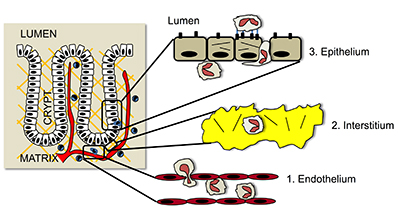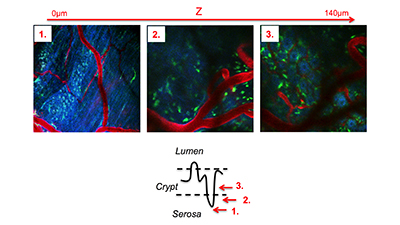Leukocyte Trafficking in Inflammation
Leukocyte trafficking is an essential component of protective responses to infections and injury. However, when out of check it may lead to severe tissue damage seen in numerous inflammatory and autoimmune disorders. Continued efforts are being made to unravel the mechanisms governing leukocyte crossing of the endothelial (blood vessels) and epithelial barriers, however, neither of the processes are fully understood. Our lab uses advanced live imaging approaches complemented with in vitro assays to investigate PMN and monocyte/macrophage recruitment in various tissues and organs in response to injury or bacterial challenge, with the goal of identifying new molecular targets aimed at improving the resolution of inflammation.

Under inflammatory conditions or bacterial infections, neutrophils that are recruited towards the intestinal lumen must initially exit the blood vessels by crossing the vascular endothelium (1), migrate across the interstitial tissue (2), and finally cross the epithelial layer (3). All three processes are tightly regulated and when dysfunctional result in exacerbated inflammation and tissue injury.
Our lab studies leukocyte behavior and trafficking in inflamed intestines following bacterial infection using real time multi-photon imaging of live, anesthetized mice. Leukocyte (green) accumulation.

Our lab studies the path that neutrophils (green) undertake while migrating towards intestinal lumen in response to bacterial infection, using real time multi-photon imaging of live, anesthetized mice. 3 planes in Z-direction are shown. (1) Superficial serosal blood vessels (red), (2) Larger vessels perfusing the intestinal crypts and (3) Crypt vasculature (blood vessels in red and crypt epithelium in blue).